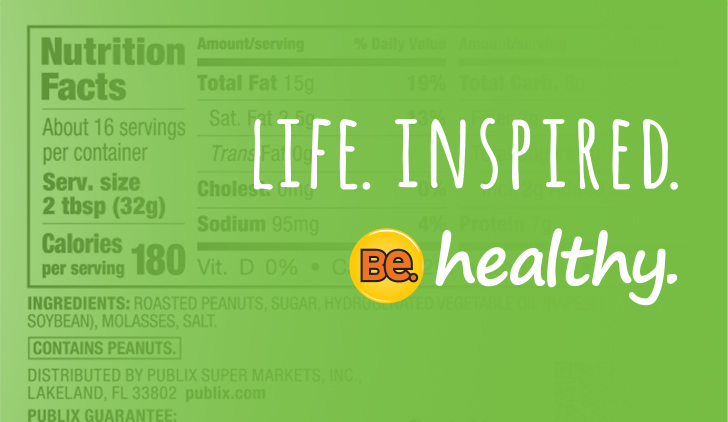
If you’ve ever looked at a food label and walked away shaking your head, you’re not alone.
Just the names of the nutrients are enough to leave some people puzzled. And how can that jar of peanut butter only contain 180 calories?
During National Nutrition Month in March, we aim to provide some insight into those confusing labels. Let’s break down nutrition facts and learn how to read and understand them.
- Serving size: The food label on each container lists the serving size first, along with how many servings it contains. That 18-ounce jar of Publix Creamy Peanut Butter contains 16 servings, and each serving equals 2 tablespoons — the amount people generally eat at one time. Just remember, while this is the amount most people eat at one time, that doesn’t mean that’s how much you should eat. Be sure to pay attention to portion sizes so you aren’t consuming too much or too little of the calories you need.
- Calories: If you measure your portions, you’re looking at about 180 calories of peanut butter per serving. If not, you could double that serving size and end up consuming 360 calories!
- Total Fat: Saturated fat is listed below total fat. Saturated fat is linked to an increased risk of heart disease, which is why the 2015 – 2020 Dietary Guidelines recommend that less than 10% of your calories per day come from saturated fat.
- Cholesterol: While there’s none in your peanut butter, it’s still important to pay attention to this number. In general, foods higher in dietary cholesterol, such as fatty meats and high-fat dairy products, are also high in saturated fat.
- Sodium: The 2015 – 2020 Dietary Guidelines recommend no more than 2,300 mg of sodium, or salt, each day to reduce your risk of heart disease, stroke and high blood pressure.
- Total Carbohydrates: This category also lists fiber and total sugars, including added sugars. Added sugars can put you at higher risk for heart disease and diabetes, as well as obesity. The 2015 – 2020 Dietary Guidelines recommend limiting added sugars to less than 10% of your daily calories.
- Protein: Protein is vital to building bones, muscles and more. The recommended daily amount is 0.36 g per pound of body weight. So, to determine your recommended daily amount, simply multiply your body weight by 0.36. For example, a 150-pound woman should get 54 g a day; a 180-pound man should get 65 g. The recommended daily amount is the minimum amount of protein you need for basic nutrition; however, the amount you should eat each day could be more based on your age, gender and activity level.
You’ll also see on food labels various minerals and vitamins like calcium, iron, potassium, vitamin D and more, all listed with their amount, if any, and their % Daily Value.
And what does % Daily Value mean? Well, that tells you how much of each nutrient is in one serving of food based on a daily diet of 2,000 calories. And the best part is the label does the math for you! For an easy guideline, you should aim for 5% or less of nutrients that should be limited such as fats, cholesterol and sodium, and at least 10% or more of nutrients you should consume more of, such as fiber, vitamin D, calcium, iron and potassium.
Feel educated and inspired? We hope so. We’ve just given you a primer to help you make more sense out of all the numbers. Your doctor or a registered dietitian can help you figure out your personal needs.
Sources: choosemyplate.gov, eatingwell.com, fda.gov, health.harvard.edu, heart.org
Need more help? Look for Publix’s Better Choice shelf tags that identify products with more of the nutrients you need, such as fiber, and less of the things you don’t need, such as saturated fat, added sodium or added sugar.


